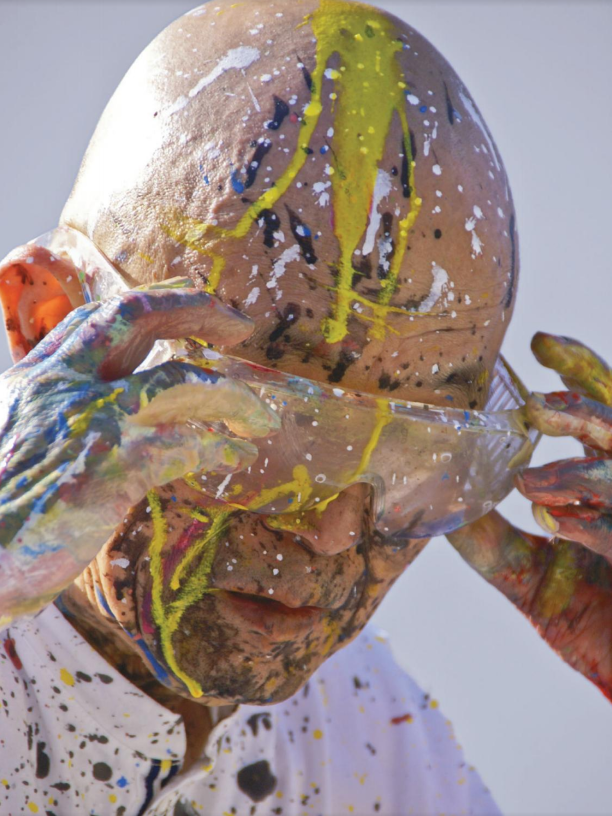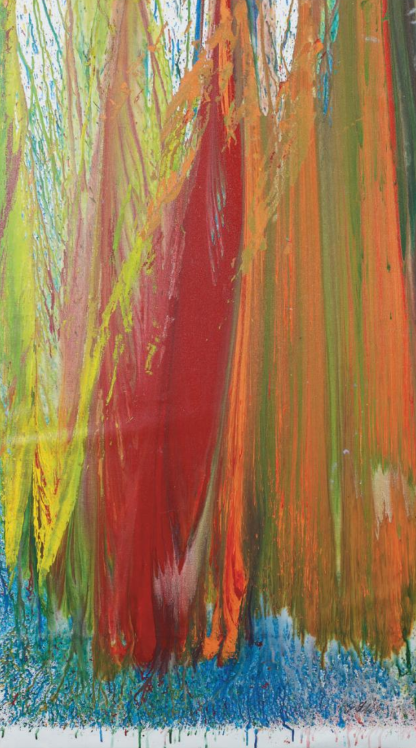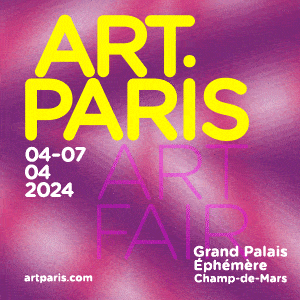Whitehot Magazine
April 2024
"The Best Art In The World"
"The Best Art In The World"
April 2024
Mark Bloch on Shozo Shimamoto at De Buck Gallery
 Shimamoto performance, Capri, Italy at Certosa di San Giacomo, May 9, 2008
Shimamoto performance, Capri, Italy at Certosa di San Giacomo, May 9, 2008
Shozo Shimamoto: Do Something Interesting, See Something Odd
De Buck Gallery, Chelsea NYC
November 3, 2016 through February 18, 2017
MARK BLOCH, MAR. 2017
Do Something Interesting, See Something Odd dove into the revolutionary career trajectory of the important Japanese Gutai artist Shozo Shimamoto who died in 2013 at 85. Several striking paintings that hearken back to earlier Gutai works and a colorful, festive video from recent years that reveals Shimamoto’s dramatic and amusing process seduced viewers with rich hues, inviting textures and an atmosphere of pure experimentation.
The exhibition provided a quick survey of the most accessible layer of the Shimamoto landscape, revealing details of his groundbreaking style and painting techniques. Centerpieces include examples of his trademark 2009-2010 Bottle Crash series and some 2011 Ping Pong works, incorporating swarms of paint-splattered ping pong balls across the surface of the canvas. Both series create echoes of an extended but specific 1957 performative “action painting” moment that characterized Gutai, the uniquely Japanese art movement of the late 1950s that used real life performative gestures evoking everything from ritual tea ceremonies to slapstick to produce an enormous body of elegant Abstract Expressionist-like works by a few dozen artists in front of audiences and led by a single charismatic leader, Jiro Yoshihiro. The first radical, post-war artistic group in Japan anticipated much of the Western performance and conceptual art of the 1960s and 70s.
 Shozo Shimamoto, Ping Pong series, 2011 (detail) Photo Courtesy of Shozo Shimamoto Association, shimamotoLAB, Inc., Andrea Mardegan, Whitestone Gallery, DeBuck Gallery
Shozo Shimamoto, Ping Pong series, 2011 (detail) Photo Courtesy of Shozo Shimamoto Association, shimamotoLAB, Inc., Andrea Mardegan, Whitestone Gallery, DeBuck Gallery
Born in Osaka in 1928, Shimamoto’s Gutai contributions have been honored in exhibitions at prominent institutions including the Solomon R. Guggenheim Museum (New York), the Museum of Contemporary Art (Los Angeles), the Centre Pompidou (Paris), and multiple editions of the Venice Biennale. His work is also represented in the permanent collections of the Tate Modern (London), and the Osaka Museum of Art.
From the early 20th century to the end of the Second World War, the wealthy, well-read and “happening” financiers of Kansai, the political and cultural center of Japan, gravitated to a real estate mecca thriving against the silhouette of Osaka’s dramatic landscape at the foot of Mt. Rokko in Hyogo Prefecture. As residential development of the land between the country’s capitals of commerce and trade crept in, Osaka and Kobe, respectively, a hip milieu emerged known as Hanshinkan Modernism. Emblematic of that rising trend was the city of Ashiya, where Japan’s most influential post-war avant-garde art group, the Gutai Art Association, was born in 1954.
The well-bred youths that gathered under the Gutai founder Jiro Yoshihara (1905–72), followed his lead: “Do what has never been done before!” and “Don’t copy anyone!”
Yoshihiro was the CEO of Yoshihara Oil, a successful company manufacturing edible oils made from soybeans and cottonseed and the heir to Osaka oil merchants active since the Edo period. Jiro took over that family business, serving as president, but kept turning out abstract paintings on the side—since middle school.
Yoshihara, self-taught, painted in Modernist styles including Surrealism until Japan’s downward spiral into militarism as WWII approached. Yoshihara didn’t pivot to the production of state-approved propaganda like his colleagues but withdrew instead to a rural setting where his work became self-reflective.
 Shozo Shimamoto working, date unknown, photographer unknown Photo Courtesy of Shozo Shimamoto Association, shimamotoLAB, Inc., Andrea Mardegan, Whitestone Gallery, DeBuck Gallery
Shozo Shimamoto working, date unknown, photographer unknown Photo Courtesy of Shozo Shimamoto Association, shimamotoLAB, Inc., Andrea Mardegan, Whitestone Gallery, DeBuck Gallery
Yoshihara realized the importance of Jackson Pollock’s kinetic techniques for painting as gestural performance in the tradition of Japanese art forms such as calligraphy or judo and after the war, he encouraged young artists to directly use their bodies to engage with their materials.
Meanwhile, Shozo Shimamoto was born in Osaka’s Yahataya, Minato-ku district in 1928 to parents working in the shipping industry, enrolling in philosophy training at Kwansei Gakuin University in 1947.
Despite a lack of any formal art courses, he was awarded a prize for a painting around the time he began school at the All-Kansai Art Exhibition.
When Shozo met Yoshihara, it would be a moment that would deeply effect both of their lives and a great many other things including all of 20th century art.
They were of two different generations. Yoshihara was a man of financial means and the leader of an art world network. Shimamoto was young and clever and eager to explore the international avant-garde and attracted to Yoshihara’s belief that thriving in a zone of freedom in a tough world is the only way to create progress in the Modern milleau of post-war Japan.
 Shozo Shimamoto working, date unknown, photographer unknown Photo Courtesy of Shozo Shimamoto Association, shimamotoLAB, Inc., Andrea Mardegan, Whitestone Gallery, DeBuck Gallery
Shozo Shimamoto working, date unknown, photographer unknown Photo Courtesy of Shozo Shimamoto Association, shimamotoLAB, Inc., Andrea Mardegan, Whitestone Gallery, DeBuck Gallery
Yoshihara had been looking for a name from about 1950 for two or three years, with a mission to “present concrete (gutai) proof that our spirit is free.” Shimamoto suggested, “Why not use the word for ‘concrete’ or ‘embodiment:’ ‘Gutai’?” Yoshihara agreed, and the approving group had a new name.
Gutai’s very Japanese brand of performance art might not have spread across the world without this initial collaboration. According to Yoshihara’s writings, “The most important thing for us is to be a place of freedom where people surviving today’s world, where times are tough for today’s art, are most liberated, in a profound belief that creating in such a free place is precisely what will contribute to human progress.”
Within Gutai the view prevailed that artworks are not about results, but are an “accumulation of acts.”
In the late 1940’s, having no cash to buy canvases, Shimamoto, cooking up glue from flour and sticking seven or eight sheets of newspaper together as a base, tore one “canvas” by accident while he was painting, and took this as inspiration for a work by the name of Holes rather than discarding it.
Even today, many of the Holes series have been called “masterpieces suffused with a vibrantly youthful quality.”
Indeed, the sculptures and paintings of the Gutai group were displayed in a pine wood subject to weathering in the open air, in July 1955 at Ashiya’s experimental Exhibition of Modern Art: to Challenge the Mid-Summer Sun. Shimamoto exhibited a perforated metal sheet. The surface erosion that began with an unintended tear evolved into conscious exploration. Shimamoto reenacted some of his art making performances for Life Magazine in 1956.
 Shozo Shimamoto, (Untitled) 2010, acrylic on newspaper, recto and verso. Photos Courtesy of Shozo Shimamoto Association, shimamotoLAB, Inc., Andrea Mardegan, Whitestone Gallery, DeBuck Gallery
Shozo Shimamoto, (Untitled) 2010, acrylic on newspaper, recto and verso. Photos Courtesy of Shozo Shimamoto Association, shimamotoLAB, Inc., Andrea Mardegan, Whitestone Gallery, DeBuck Gallery
In the Gutai Art Manifesto of 1956, Yoshihara declared, “We believe that by merging human qualities and material properties, we can concretely comprehend abstract space.”
Similar to Rauschenberg and Johns in the U.S., it was a collaboration with materials. It was also similar to Lucio Fontana in Italy who Shimamoto had not heard of but who would slash his canvasses to critical fanfare.
Shozo had showed “Holes” to Yoshihara, who praised it, then suggested they put it in a magazine so critics might come to understand it. “You organize it,” he said, unilaterally delegating the job to Shimamoto.
The inaugural edition of Gutai was mailed to art museums and art enthusiasts in Japan and elsewhere. Printed in a storage shed at the Shimamoto home on a borrowed printing press, Gutai members alternated between print runs and typesetting. Between three and eight hundred copies of the first edition were printed, depending on who you ask. But the result was clear: the Japanese response was non-existent. Gutai never did appear in the cultural pages of the newspaper, but invariably the general news headings would ask, “And they call this art?” The media seem to have viewed Gutai as a mere curiosity.
There was however some reaction from overseas: Jackson Pollock was later found to have in his possession the second and third issues of Gutai. Collagist Ray Johnson wrote a letter of introduction to Yoshihiro some 30 years before he began corresponding with Shimamoto within the mail art network. Finally, the influential inventor of Happenings in the United States, Allan Kaprow, featured Gutai in his 1966 book Assemblage, Environments & Happenings.
 Shozo Shimamoto, (Untitled), 1993 Photo Courtesy of Shozo Shimamoto Association, shimamotoLAB, Inc., Andrea Mardegan, Whitestone Gallery, DeBuck Gallery
Shozo Shimamoto, (Untitled), 1993 Photo Courtesy of Shozo Shimamoto Association, shimamotoLAB, Inc., Andrea Mardegan, Whitestone Gallery, DeBuck Gallery
The title of one early Shimamoto work was Please Walk on Here. Inside a box “a long line of boards serving as springs, designed so that the boards bow under the weight of being walked on” creating an uncomfortable experience and lack of stability—artworks up to then were for viewing— and this physical experience of a work of art was revolutionary.
Another big breakthrough for Gutai was in 1956 when Shimamoto used acetylene gas to spray paint through a pipe 4 meter long and 30 centimeters in diameter, onto a 10 meters squared piece of red plastic. The exploding pigment scattered across the surface of the plastic, a process that instantly upended expertise in composition and color.
In 1957 Shimamoto took part in Gutai Art Using the Stage at the Sankei Kaikan in Osaka and Sankei Hall in Tokyo. Under the title Smashing Objects, he struck tubes packed with ping-pong balls, and boxes packed with confetti. He created unexpected results in real time.
Pieces such as the 2011 Untitled (Ping Pong), incorporating ping pong balls scattered across the surface of the canvas and displayed here, exemplify a characteristic playfulness reminiscent of the earlier works.
Similarly, Shimamoto also used chance to create instant works by hurling pigment-filled bottles at fabric spread on the floor in the 1950’s, with fragments of glass and pigment comprising the art product and then used a five-meter cannon in the 50’s to paint instant pictures when plastic bags of color were loaded and shot onto canvas.
Here at De Buck, a celebration of the maturation of Mr. Shimamoto’s playful career featured the results of the ceremonious throwing of bottles and other containers full of pigment at blank canvases—in several acrylic Bottle Crash works—collected from his reenactments in the 21st Century that posthumously represented him in the Chelsea gallery.
Back in 1962, Jiro Yoshihara, as a testament to his trust in the young artist, chose Shimamoto to premier the first solo show at the Gutai Pinacotheca, an old remodelled earthern storehouse he owned in Nakanoshima, Osaka.
 Shozo Shimamoto, (Untitled), 2009 Photo Courtesy of Shozo Shimamoto Association, shimamotoLAB, Inc., Andrea Mardegan, Whitestone Gallery, DeBuck Gallery
Shozo Shimamoto, (Untitled), 2009 Photo Courtesy of Shozo Shimamoto Association, shimamotoLAB, Inc., Andrea Mardegan, Whitestone Gallery, DeBuck Gallery
Shimamoto, having endured the early years of Gutai, steadily came into his own and became one of the featured members of the group while always yielding to his elder colleague. When the movement was initially formed, the turnover of new members was so high Shimamoto advised the disciplinarian Yoshihara “Please try to ease up a little.” Thus he convinced Shiraga, Murakami, Tanaka and others, belonging to the O-kai in Amagasaki, Hyogo group, to join the exciting and free-spirited nature of Gutai: the artist Sadamasa Motonaga did paintings using the tarashikomi drip technique; Kazuo Shiraga famously battled half-naked with mud, painting with his feet; Saburo Murakami made his name with paper-tearing performances; and Atsuko Tanaka appeared on stage in electric clothing.
At the same time Shimamoto, continuing to hurl pigment, also pushed boundaries by presenting work in video and audio work using a tape recorder, early experiments with media art.
But in 1972 Yoshihara’s sudden death brought eighteen years of activity to a halt, and the Gutai group disbanded.
By the mid 1970’s, Shimamoto became secretary general of the Artists’ Union (AU) in Osaka, eventually immersed in an international mail art network with 8000 exchanges annually in 60 countries. Shozo made several tours abroad, often inviting artist friends to draw, write, place objects or project films on his shaved head. The collaborations were photographed. At the beginning of the 1980s I personally received an introduction and Shimamoto’s often-used “A” symbol, the first letter in the Japanese alphabet, which I was asked to transform and send back. This led to many years of correspondence between us and some face-to-face collaborations in New York in 1985.
Meanwhile, Shimamoto held posts such as professor emeritus at the Kyoto University of Education, and lecturer at the Takarazuka University as an art educator. These activities overlapped with Shimamoto’s work with AU as he and his students created an impressive bimonthly offset-printed, folding poster for the art group he led known as AU Art Unidentified and mailed from Shimamoto’s studio, an art space in Koshienguchi in the city of Nishinomiya, Hyogo, today known as shimamotoLAB Inc.
In 1996, he was nominated for the Nobel Peace Prize by scientist-artist and publisher Bern Porter, who quit the Manhattan Project in protest after Hiroshima was bombed.

Photo of Bern Porter writing on Shimamoto's head, itself projected on Shozo's head Photo Courtesy of Shozo Shimamoto Association, shimamotoLAB, Inc., Andrea Mardegan, Whitestone Gallery, DeBuck Gallery
In more recent years Shimamoto also conducted sessions both in Japan and elsewhere that involved hurling bottles down onto a sheet of fabric while suspended from a crane 30 meters up, serving both as performance and open studio.
Shimamoto’s artistic output was penetrated from beginning to end with the characteristic inquisitiveness of an Osaka native: the desire to “do something interesting, see something odd.” Also at play was perhaps the notion of how important it is to make a “splash.” Thus he moved from paintings with holes to cannon painting to hurling bottles, from mail art, crane painting, head art, and finally back to bottle-throwing paintings. Here was an artist embracing the spirit of the times, living each moment in a serious quest for the essence of the here and now, manifesting a cultivated intuition as he experienced it, giving it form, always with sensitivity, and changing as he went.
With dual identities as an avant-garde artist and educator, Shimamoto also turned his attention to the socially disadvantaged. He made a project out of a group run in support of the incarcerated Native American Leonard Peltier in the United States. Later in life, he was also involved in disabled art, serving as president of the Association of Art, Culture and People with Disabilities, Japan (now Able Art Japan) and instrumental in showcasing the work of outsider artists.
 (Untitled), 2010 Photo Courtesy of Shozo Shimamoto Association, shimamotoLAB, Inc., Andrea Mardegan, Whitestone Gallery, DeBuck Gallery
(Untitled), 2010 Photo Courtesy of Shozo Shimamoto Association, shimamotoLAB, Inc., Andrea Mardegan, Whitestone Gallery, DeBuck Gallery
On January 25th, 2013, three days after his 85th birthday, legendary artist Shozo Shimamoto died of heart failure. A memorial event titled Shozo-ism was held at Hotel Novotel Koshien, Osaka West in Japan. On the occasion of the exhibition Shozo Shimamoto: Do Something Interesting, See Something Odd, an exhibition catalogue has been published, featuring an essay by curator Yoshio Kato who worked for the artist as a graphic designer and staged an exhibition in February 1987 tracing 40 years of his work at an Osaka gallery.
It was gratifying to see evidence in this gallery, in the form of video and the two dozen paintings or more, of the late Shimamoto moving confidently in the direction of a full engagement with life, reminiscent of the explosive spirit of the underappreciated movement called Gutai. “To produce art is to do something beyond your capabilities,” Shimamoto not only said, but lived. WM

Mark Bloch
Mark Bloch is a writer, performer, videographer and multi-media artist living in Manhattan. In 1978, this native Ohioan founded the Post(al) Art Network a.k.a. PAN. NYU's Downtown Collection now houses an archive of many of Bloch's papers including a vast collection of mail art and related ephemera. For three decades Bloch has done performance art in the USA and internationally. In addition to his work as a writer and fine artist, he has also worked as a graphic designer for ABCNews.com, The New York Times, Rolling Stone and elsewhere. He can be reached at bloch.mark@gmail.com and PO Box 1500 NYC 10009.
view all articles from this author








